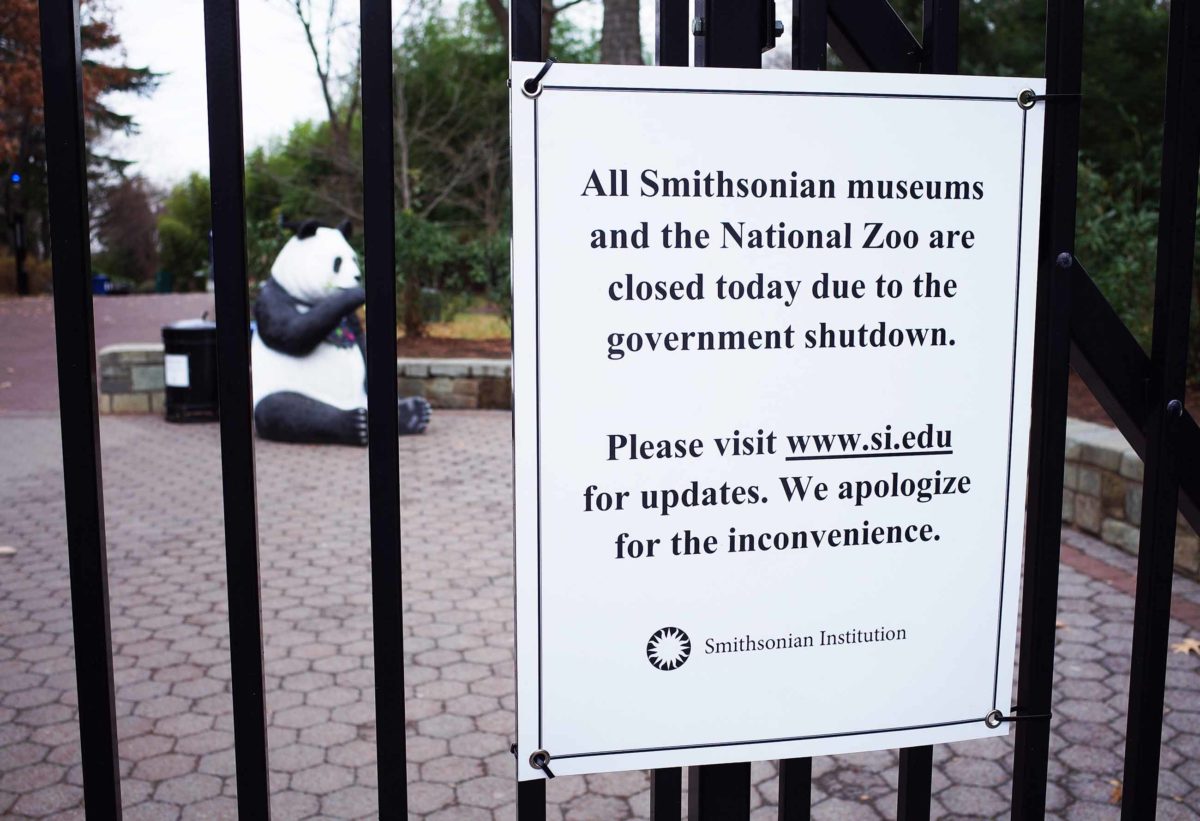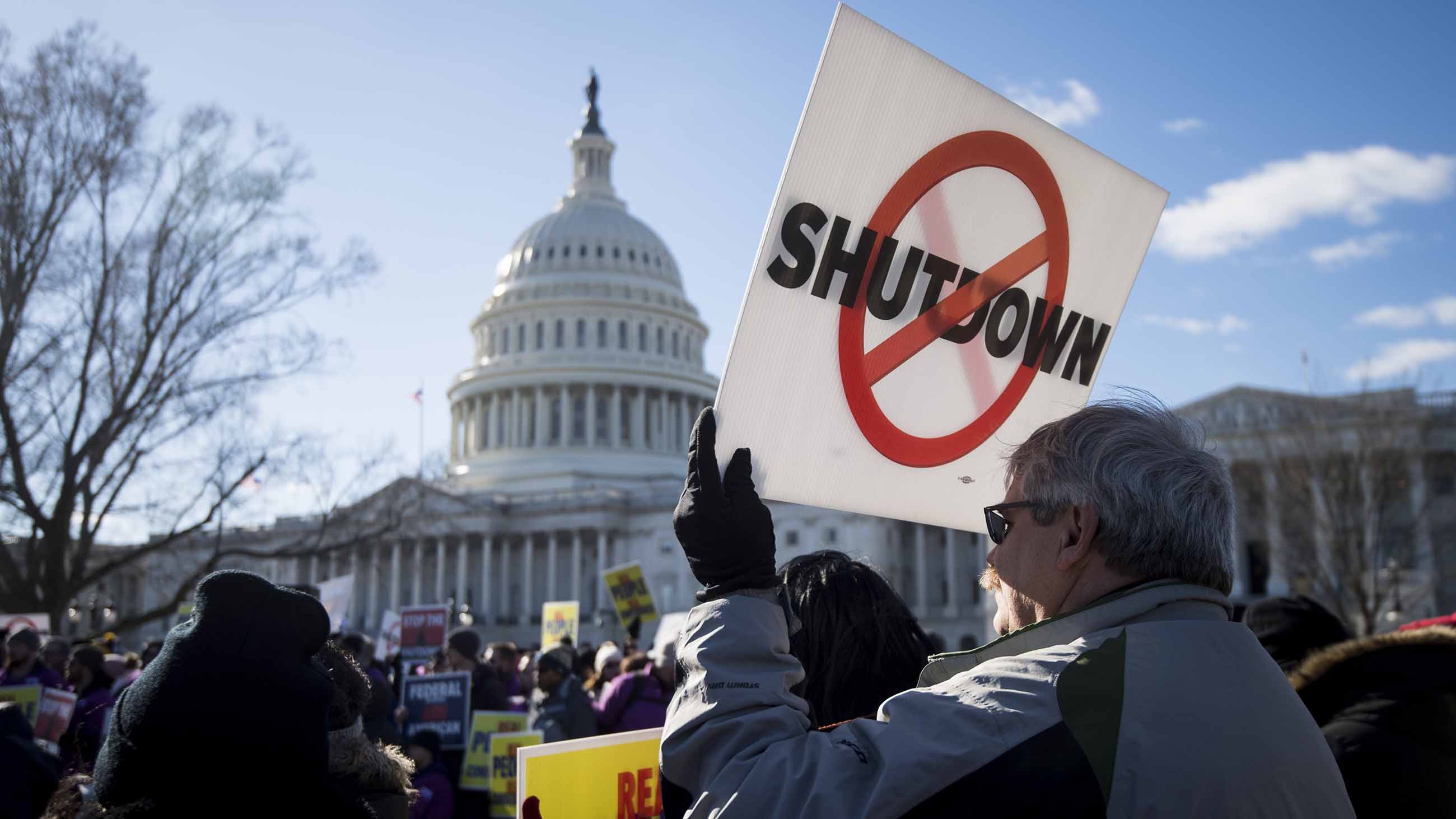The current shutdown of the U.S. federal government has now lasted as long as any other in history, and roughly 800,000 federal employees have either been idled or, where their services are considered vital, forced to toil without pay. Increasingly, that latter category does not include scientists — and the impacts of the paralysis reach even further, affecting private or academic research projects that rely on federal funds, work on federal lands, or include collaborations with federal scientists.

The federal government shutdown has now lasted as long as any in history — and the impacts are spreading.
Visual: MANDEL NGAN/AFP/Getty Images
In some cases, decades-long studies could be hobbled in ways that can never be repaired.
Such is the case for example, for Jeff Atkins, an ecosystem ecologist working to sample water in Shenandoah National Park. Barred from entering the park since late December when the shutdown began, Atkins was unable to collect weekly water samples for a long-running acid rain monitoring project — the first gap in the data in nearly four decades, The Washington Post reported this week. “Now I have a hole in the data set,” Atkins told The Post. “It’s just a needless problem.”
Science Magazine noted on Wednesday that Atkins had been permitted to resume his sampling, but the damage was done. And his experience is being replicated in ways large and small across the country, as President Donald J. Trump squares off against Democratic leaders in Congress over funding for a wall along the nation’s southern border. Tens of thousands of scientists are feeling the pinch, Science noted, from the National Oceanic and Atmospheric Administration’s Cooperative Oxford Laboratory in Maryland, to NASA’s Jet Propulsion Laboratory in Pasadena, California, where one researcher, Rachel Storer, was forced to halt work because the NASA supercomputers she relies on are unavailable. “I have other work to fill my time,” she told the magazine, “… but it’s a setback.”
Those scientific setbacks are likely to snowball quickly if the shutdown continues — particularly as already-allocated funding dries up, resources go on lock-down, and public-private partnerships splinter.
Some science-based agencies that were funded through previous appropriations bills do remain open, including the National Institutes of Health and the Department of Energy, Wired magazine reported on Tuesday. But everything from weather forecasting to environmental regulatory enforcement increasingly hangs in the balance as the effects of the shutdown ripple throughout the deeply interconnected scientific community and the many support structures and personnel on which researchers rely.
Ian Taylor, an operations research analyst with NOAA’s Northwest Fisheries Science Center, told Wired he’s been spending more time at home with his family since his fishing stock assessments were halted: “We’ve been cleaning out our closets,” he said.
Also in the news:
• The shutdown is also stalling updates to the World Magnetic Model, a system at the heart of all navigation tools that is badly outdated — particularly in light of a recent erratic shift in the north magnetic pole, Nature reported this week. Driven by churning liquid at the Earth’s core, there’s nothing unusual about the pole moving off course, and scientists have been documenting its drift since at least the early 19th century. But this shift has been particularly dramatic, quickly pushing the pole away from Canada and towards Siberia. The precise cause remains a mystery, but researchers speculate that it could be linked to a surge of liquid iron beneath Canada, or “hydromagnetic” waves, surges that move along magnetic field lines the way a vibration travels along the length of a guitar string. A team of geomagnetists, originally scheduled to convene in 2020 to update the model, pulled the date back to January 15, 2019 to respond to the anomalous shift. But given the shutdown of the U.S. federal government, which helps oversee the project, they have been forced to postpone. A new meeting has been scheduled for January 30. (Nature)
• Coal plants are shuttering, the renewable energy sector is flourishing, and automobile fuel economy is improving. By some accounts, the U.S. would appear to be making considerable progress toward the fossil-fuel reductions necessary to avert a climate crisis. But a report published this week by the independent research firm The Rhodium Group paints a more sobering picture: The firm estimates that America’s carbon dioxide emissions spiked by 3.4 percent in 2018, the biggest increase in eight years and a reversal of a three-year downward trend. The uptick is largely a byproduct of a humming U.S. economy. In 2018, truck and air travel picked up, the demand for electricity spiked, and emissions from industrial plants soared. But experts also partially attribute the jump to Trump administration rollbacks of Obama-era climate regulations. “What we’ve seen is backsliding in federal policy,” Trevor Houser, a partner at The Rhodium Group, told NPR. “And we’re starting to feel the effects of that now.” Trump has famously announced plans to withdraw from the 2015 Paris Climate Agreement — though technically, that move can’t be completed until 2020. Either way, absent a wave of new regulations or technological advances, the Rhodium Group warns, it may now be impossible for the U.S. to reach the 2025 emissions goals set forth in the treaty. (The New York Times)
• The controversial writer Malcolm Gladwell — once described as “pseudo-profound” by the New Statesman — drew a swift backlash this week from both health experts and his fellow science journalists after the publication of a New Yorker piece titled “Is Marijuana As Safe as We Think?” Gladwell’s article, which pointed out the many unanswered questions regarding the health risks of marijuana exposure, also highlighted a recent book by novelist Alex Berenson, which is dedicated to exploring the possible dangers of such exposure. Berenson has been recently promoting the book on platforms ranging from Tucker Carlson’s show on Fox to The New York Times, and has himself been subject to a wide range of critics, who charge that he manipulates statistics to make his case and misstates the scientific record. Those unhappy with Gladwell’s coverage complain that the reporting is superficial, that he drew his information almost entirely from Berenson’s work, and that the resulting story was mere scare-mongering. The result was a storm of criticism on Twitter this week, to which Gladwell responded by comparing the critics to climate-change deniers. (Boing-Boing)
• Chinese researcher He Jiankui faced a wave of backlash late last year after news broke that twin girls had been born from embryos he’d altered using the gene-editing tool Crispr-Cas9. But contrary to reports that he is being held by the government — and may even face the death penalty — He has reported to colleagues that he’s “actually doing quite well.” According to William Hurlbut, a neuroscientist and bioethicist at Stanford University, He is living in a university apartment in Shenzhen and is protected by a guard, though he’s free to come and go. Hurlbut said He relayed that he’s glad of the security, as he’s received threatening messages regarding his decision to alter the embryos’ CCR5 genes to prevent future HIV transmission. While He has defended his actions by citing the growing prevalence of the disease in his country, critics point out that there are easier ways to prevent and treat HIV. He is currently under investigation by China’s Ministry of Science and Technology, though it’s unclear whether his actions violated the country’s “Ethical Guidelines for Human Embryonic Stem Cell Research.” (STAT)
• And finally, a trumped up climate science scandal has reached a quiet conclusion. It began with a breathless 2017 report published by the UK’s Daily Mail, which purported to expose a clear case of scientific malfeasance: Researchers at the U.S. National Oceanic and Atmospheric Administration had doctored data in a 2015 paper in order to exaggerate global warming trends, the report suggested, and to downplay certain lines of countervailing evidence. The charges were based on the musings of a “whistleblower” and former NOAA climate researcher, John Bates, and it spurred outrage among climate skeptics, including Republican members of Congress, who demanded an investigation. It took little time for the story to fall apart, of course — not least when Bates himself backpedaled, claiming that the British tabloid had mischaracterized his largely bureaucratic complaints. The Daily Mail, meanwhile, was forced to publish a lengthy correction detailing its own journalistic failures — but an investigation by the federal agency that oversees NOAA, the U.S. Department of Commerce, marched onward. The results of that were quietly published just as the federal government went into shutdown mode late last month, and researchers only really got wind of it this week, according to Ars Technica. Nothing of substance was found, though some sound recommendations for improving NOAA’s protocols for submitting scientific papers were offered. At the RealClimate blog, climate scientist Gavin Schmidt called the whole affair a “NOAA-thing burger,” adding: “What a colossal and counter-productive waste of everyone’s time.” (Ars Technica, RealClimate)










